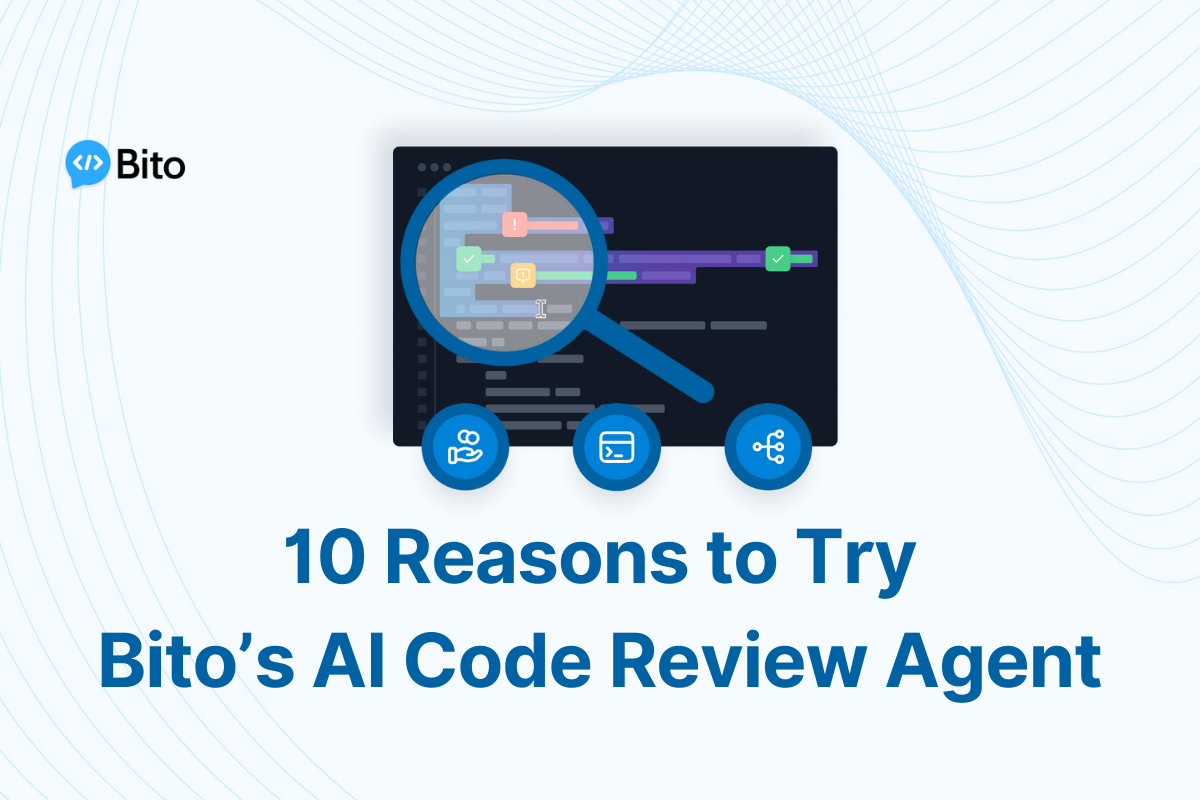Code reviews—developers either love them or dread them. Most of us spend hours staring at pull requests, trying to catch bugs, or debating things like variable names and code structure. Traditional human reviews are necessary, but they’re also slow, inconsistent, and sometimes exhausting.
That’s where Bito’s AI Code Review Agent can really help.
Teams using Bito’s AI reviews merge code faster, catch bugs earlier, and spend less time dealing with repetitive review tasks.
Wondering why so many developers now trust AI to improve their code reviews? Here are ten practical reasons you might want to give Bito’s AI Code Review Agent a try.
1. Lightning-fast code reviews (speed up your merges)
Traditional human code reviews can bottleneck your development flow – waiting on busy teammates or resolving comments days later slows everyone down.
Bito’s AI Code Review Agent tackles this by delivering immediate feedback on your pull requests, so you can merge code faster.
In fact, teams using Bito have merged PRs up to 89% faster on average.
The AI works 24/7 without breaks, meaning no more stalling your release until someone has time to review. As a result, we’ve seen sprint cycles shrink – Bito users even report winning back a full day of productivity each sprint.
The speed boost is noticeable: you push code, and within minutes, Bito’s automated code review provides insightful comments. This rapid turnaround keeps developers in the zone, enabling quick fixes and fewer drawn-out review cycles.
Bottom line: Faster reviews = faster releases, which is a huge win for any software team.
2. Thorough reviews that catch more bugs
No matter how experienced, human reviewers can miss things – especially in large diffs or under time pressure. Bito’s AI excels at thoroughness. It performs a 90+ point analysis on every pull request, systematically checking for errors, code smells, and best practices. The result is fewer bugs slipping through.
Teams using Bito have seen 34% fewer regressions after adopting the AI reviewer. In my own experience, Bito often flags subtle issues we might overlook – for example, a mis-typed data field or a missing null-check that could cause a runtime error.
It also goes beyond bug catching: the agent suggests improvements in code structure, error handling, and edge-case handling.
One of my favorite parts is that its suggestions are “pro-quality” fixes that are usually ready to apply without heavy rework. This thoroughness gives me confidence that by the time we merge, the code is solid. Simply put, Bito acts like an extra pair of senior engineer eyes on every change, reducing the chance of nasty surprises post-merge.
3. Deep context awareness (understands your codebase)
A standout feature of Bito’s AI Code Review Agent is its codebase awareness. Unlike simple lint tools or AI that only look at the diff, Bito analyzes changes in the context of your entire repository.
It builds an understanding of your codebase’s architecture using techniques like Abstract Syntax Tree parsing, symbol indexing, and embeddings.
Why does this matter?
It means the AI “knows” your code. It recognizes usage of functions and classes across files, understands dependency relationships, and is aware of your project’s patterns. This context awareness leads to more precise, relevant feedback.
For example, if you modify a function that other modules rely on, Bito will consider those impacts before commenting. The agent brings a contextual insight “just like a senior engineer”.
In practice, I’ve seen far fewer “noise” comments – Bito won’t suggest something that doesn’t fit your codebase’s context.
Competing tools like Graphite’s Diamond AI reviewer also emphasize whole-codebase analysis, underscoring how crucial this capability is. Bito’s implementation is particularly advanced, effectively reviewing code with an understanding of the bigger picture.
The outcome: you get insightful code reviews that truly grasp your project, not generic advice.
4. All-in-one code quality toolkit (lint, static analysis & more)
Bito’s AI Code Review Agent doesn’t stop at just style comments – it comes loaded with integrated static analysis and linting tools to elevate code quality.
Under the hood, Bito runs best-in-class analyzers (like Mypy for Python and Facebook Infer for other languages), plus linters such as ESLint, golangci-lint, Ruff, and more. It also performs security scans with tools like Snyk and detect-secrets to catch vulnerabilities or leaked secrets.
This means when Bito reviews your code, it’s doing the work of multiple tools at once – type checking, bug finding, style enforcement, and security auditing – and then surfacing the results in a unified review.
For a developer, that’s incredibly convenient. Instead of juggling separate CI checks or manual tool runs, the AI delivers a consolidated set of findings alongside its own AI insights.
I’ve been impressed to see it flag things like a potential SQL injection risk or an API key accidentally left in code – issues that go beyond typical code review commentary.
In short, Bito acts like a full-stack code quality guardian, automating the heavy lifting of static analysis along with intelligent feedback. This not only improves code health but saves developers time from running multiple tools.
Traditional human reviews rarely include such exhaustive checking due to time constraints, so this is a big advantage over a purely manual process.
5. Smart, actionable feedback (not just complaints)
One thing I appreciate as an engineer is that Bito’s feedback is actionable and educational, not just a list of complaints.
Each comment it leaves comes with context and explanation. Bito doesn’t just say “this is wrong” – it often explains why an issue matters or how a fix will improve the code. This extra context is motivating; in fact, teams have noted that Bito’s feedback “provides context and impact, which motivates developers to improve”.
For junior developers on my team, this has been like a mini mentorship: the AI’s comments teach best practices in real time. Even as a senior dev, I’ve picked up on a few new library functions or techniques from its suggestions.
The feedback is also presented in a scannable, friendly manner – such as inline code suggestions for small fixes (which you can accept with one click), a quick summary of the change that outlines what the PR does, classifies the change type (feature, bugfix, etc.), and even estimates review effort. This gives human reviewers a head start.
Overall, the style of feedback feels like a collaborative engineer rather than a lint robot, which makes the code review process more pleasant and productive.
6. Customizable to your team’s needs
Every codebase and team has its own norms, and Bito recognizes that. The AI Code Review Agent is highly customizable, so you can tailor its behavior to fit your guidelines.
You can provide custom code review rules and preferences – for example, if your team has a specific way to structure unit tests or a naming convention to enforce, you can teach those to Bito. The agent will then automatically flag any deviations from your defined best practices. Over time, it even learns from your feedback: if you dismiss certain types of suggestions consistently, it refines its recommendations accordingly. I found this “learning” aspect great – it means the AI gets better aligned with our project as we use it.
Bito also offers specialized review commands that let you focus the AI on specific concerns when needed. For instance, you can comment on a PR with /review security and Bito will specifically analyze the code for security issues, or /review performance to get feedback on inefficiencies.
This targeted analysis is like calling in an expert for a particular domain on demand. It’s saved us time when we wanted an extra-thorough security check on sensitive code. No other code review tool offers this level of targeted control – it’s a unique perk.
And if you’re an enterprise user, you can even run Bito in a self-hosted mode with fine-tuned configuration files to integrate with your internal systems.
The flexibility to customize and self-host means Bito can fit into small startup teams or large organizations with strict requirements. It’s not a black-box SaaS that you hope will follow your rules – you can make sure it does.
7. Seamless integration with your workflow
As developers, we’re allergic to tools that disrupt our established workflow. Bito gets this – it integrates seamlessly with the tools you already use.
Setup is straightforward (one click to connect the agent with your GitHub, GitLab, or Bitbucket repositories), and then the AI review comments appear right in your Git pull requests.
There’s no separate interface to learn or context-switching to a new app. In my case, after enabling Bito on our GitHub repository, it started commenting on PRs just like a human reviewer would – in the familiar code review UI. This meant zero friction for the team to adopt it. We all see the AI suggestions alongside our peer comments and can discuss or accept changes as needed.
Bito even works with self-hosted versions for GitHub and GitLab.
It has CI/CD integration options and can be triggered automatically when a PR is opened or updated. The agent is smart about updates too: it does incremental reviews, focusing only on new changes when you push updates to a PR. This is just like a good human reviewer who doesn’t rehash old comments after you’ve fixed them.
8. Boosts team productivity and collaboration
Bito’s AI Code Review Agent doesn’t just save time – it also positively impacts team productivity and how developers collaborate.
By handling a large chunk of review comments automatically, Bito frees up human reviewers to focus on high-level feedback and architectural discussions rather than nitpicks.
One case study found teams started saving 30–35% of the human hours spent on code review each week after introducing Bito.
In my team, we’ve definitely noticed that code reviews take less of our time, yet the overall quality has gone up.
Developers can spend those saved hours on building features or improving design, instead of combing through code for minor issues – the AI does that part for us.
Interestingly, using an AI reviewer has also smoothed out some human dynamics of code review. Bito provides objective, consistent feedback, which has helped reduce interpersonal friction.
As one CTO noted, it “minimizes interpersonal pushback in PRs”.
I’ve seen this firsthand: it’s sometimes easier to accept critique from an AI (that has no ego) than from a colleague in a public code review thread. Junior developers, especially, feel less pressure when an AI suggests a change, as opposed to a senior engineer – it feels like the tool is guiding them, not personal criticism. This has led to a more positive, learning-focused review culture on our team.
Bito also makes knowledge sharing easier. Its comments often explain best practices, which both seasoned and novice developers can learn from.
Over time, this raises the baseline of code understanding across the team. And because the AI is involved in most reviews, even if a senior dev is out on vacation, the junior devs still get thorough feedback on their PRs. Code quality becomes less dependent on specific reviewers being available.
All of these factors contribute to a productivity boost: code gets reviewed and merged faster, developers grow their skills, and the whole team maintains a high standard without burning out the few experienced reviewers.
9. Strong security and privacy safeguards
If you’re worried about an AI tool exposing your code or secrets, Bito has you covered. It’s designed with a security-first approach.
First, none of your code is stored by Bito and it doesn’t use your code to train its AI models. All analysis is ephemeral and for your eyes only. Bito is also SOC 2 Type II certified, meaning it has passed rigorous security audits for data protection. For many companies, these assurances are essential before trusting an AI service with proprietary code.
For even greater control, Bito offers an on-premises deployment option. You can run the AI Code Review Agent on your own infrastructure (via a Docker container). This is ideal for organizations with strict compliance requirements or ultra-sensitive codebases.
Few AI code review tools provide a self-hosted option – this really sets Bito apart for enterprise use. By contrast, other AI code review solutions are often cloud-only. (CodeRabbit, for example, runs via cloud and any on-prem capability is reserved for enterprise contracts, and Graphite’s Diamond is a cloud service tied to GitHub.). With Bito, even a security-conscious team can adopt AI reviews without hesitation.
Beyond the privacy of using the tool, consider the security of your code itself. Bito’s integrated security analysis (with tools like Snyk and detect-secrets) means it actively looks out for vulnerabilities in the code under review. It might catch a misconfigured encryption call or a leaked credential in a commit that a human reviewer might not notice.
This adds an extra layer of defense to your development workflow.
Essentially, Bito improves your security posture while respecting your privacy.
As a senior engineer, that combo gives me peace of mind – we get the benefits of AI automation without opening any security holes.
10. Proven in the field (developers love it)
Finally, one of the best reasons to try Bito’s AI Code Review Agent is the real-world validation behind it. This isn’t just theoretical tech – many development teams (from startups to larger orgs) have adopted Bito and seen tangible improvements.
The feedback has been very positive.
To quote a few fellow engineers: “Bito’s AI Code Review Agent is the first we have seen that really does the job.” and “Teams felt a difference immediately and started saving 30% to 35% of human hours… each week.”.
Developers report being happier and less stressed with Bito in the loop – 82% of devs in one survey said their happiness increased, saving them 2+ hours per day on average. Those are massive quality-of-life gains for a dev team.
I was admittedly skeptical at first that an AI could handle code reviews so effectively. But after using Bito on dozens of PRs, I’ve become a believer. The agent’s suggestions are on-point enough that we treat it as an essential team member now.
It’s also worth noting that in side-by-side comparisons with other AI code review tools, Bito consistently shines. For example, compared to CodeRabbit (another AI reviewer), Bito’s agent offers deeper codebase understanding and more thorough issue detection – essentially reviewing code like a seasoned senior developer, rather than just a basic lint bot. Similarly, while new entrants like Graphite’s Diamond AI have appeared, Bito has the advantage of maturity and a broader feature set (analytics, multi-platform support, etc.).
Knowing that Bito has been battle-tested in real developer workflows gave me the confidence to trust it in ours.
Lastly, trying out Bito is low friction. There’s a free trial (14 days) and even a free plan for small teams, so you can see its impact firsthand with minimal commitment. Our team’s experience was that within the first week, we could already tell this tool was making our lives easier. The ROI became pretty obvious – and Bito quotes an ROI of $14 for every $1 spent, based on productivity gains, which I can’t argue with now that I’ve seen the results.
Conclusion
In summary, Bito’s AI Code Review Agent has proven itself as a reliable, efficient, and insightful assistant for code reviews. It speeds up development, catches more issues, and helps the whole team improve – all while integrating nicely and keeping your code secure.
As a senior engineer who’s seen the before-and-after, I encourage you to give it a try and experience how much smoother your pull request process can be with a bit of AI help.
In the fast-paced world of software development, leveraging an AI code review tool like Bito might just become your secret weapon for better code and happier devs.
You don’t have to take my word for it – try it out on your next PR and see the difference it makes in your team’s software development productivity. You might wonder how you ever got along without it!
FAQs
Q1. What makes Bito’s AI code review tool different from other tools?
Bito combines AI models with code indexing, ASTs, and static analysis so reviews are codebase-aware instead of diff-only. It focuses on real issues that affect production rather than spamming style nits. Bito
Q2. How quickly can a team see value from Bito’s AI code reviews?
Once connected to GitHub or GitLab, teams usually see useful feedback on the first real PR. As you tune rules and respond to suggestions, the agent aligns better with your standards and cuts down the number of review cycles needed.
Q3. Does Bito’s AI code review agent work with our existing workflows?
Yes. It plugs into your existing Git workflows and posts comments inline on pull or merge requests. You don’t have to change your branching model or CI pipeline to start using it.
Q4. Will an AI code review tool slow down my CI pipeline?
Bito is designed to run reviews in parallel to existing checks. Reviews complete in the background while tests run, so by the time a reviewer opens the PR, much of the feedback is already waiting.
Q5. What kind of issues does Bito’s AI code review agent focus on?
It looks for logic bugs, performance issues, risky patterns, missing tests, maintainability problems, and security risks, not just formatting. The goal is to behave like a senior reviewer, not a linter with a new label.






